Measuring the impact of travel apps on travel habits is not an easy question to answer; perhaps it’s not even the right question to be asking. Everyone who travels can recognize the relentless impact technology is having on commercial and leisure travel. But getting past the influence of personal travel experiences (that guy just boarded with his smartphone!) to make sound observations on technology and travel isn’t as straightforward as it might seem. Yet that’s the challenge: to look at travel technology – specifically mobile apps - and determine what effect, if any, they’re having on travel habits.
Google’s “The 2014 Traveler’s Road to Decision” makes it clear leisure travelers take their first decision-making steps using three types of information sources. The largest two are the Internet and trusted relationships - friends and family. The third is a conventional group which also used by parents and grandparents of today’s millennials: books and newspapers; TV and radio; magazines and brochures. As the graphic shows, the Internet is tied with friends and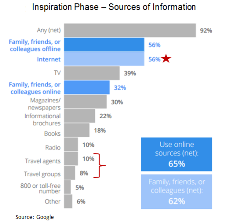 family as the most dominant source of information while the only travel sources – agencies and travel groups - are found near the bottom.
family as the most dominant source of information while the only travel sources – agencies and travel groups - are found near the bottom.
A reasonable conclusion from this information is that traveler habits during the initial Inspiration phase of leisure travel haven’t been impacted in any significant way by the technology that has entered the industry over the past ten years. The Internet has become a new to gather information, but the long standing inclination of people to use trusted, neutral, arms-length sources to learn about travel possibilities remains.
The Role of Apps in Mobile Technology
The standoff in the Inspiration phase of the travel lifecycle between the Internet and friends and family is a good reminder that the purpose of any technology is to enable a more effective way for people to achieve goals and objectives. In the Inspiration phase, Internet technology provided a faster way to gather travel content than books, newspapers and magazines. However, it couldn’t replace first hand, or even second and third hand, travel ideas and recommendations from trusted people.
The growing interest in – and attention paid - to the effect mobile applications are having on the travel industry creates three impressions.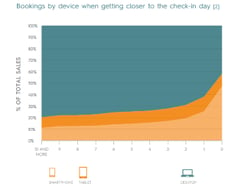
- One, this growth is driven by real advantages to mobile users.
- Two, the motivation of mobile users in general and mobile travel users in particular is essentially the same.
- Three, mobile technology is young so growth should only increase.
These impressions are reinforced by the Criteo Travel Flash Report, Sept 15th 2015, which shows continual increases in mobile applications as a way to book travel. Particularly arresting is the graph which displays a clear correlation between method of booking and days remaining before travel. The dramatic shift to mobile as time runs out certainly supports the premise that mobile growth is driven by real advantage.
Drawing clear conclusions about the role of mobile applications in travel gets difficult when information about the general use of those devices has to be taken into account. Data on general mobile a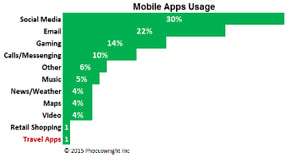 pplication usage from non-travel sources can often seem to be sending very different messages than those from the travel industry. This graph is a good example of the conundrum: almost 70% of mobile application use is strictly for social interaction and personal enjoyment – social media; email and games, items that aren’t necessarily even considered an app by most people. It could be argued those three types of software are so ubiquitous as to not even come to mind when the subject of apps is mentioned.
pplication usage from non-travel sources can often seem to be sending very different messages than those from the travel industry. This graph is a good example of the conundrum: almost 70% of mobile application use is strictly for social interaction and personal enjoyment – social media; email and games, items that aren’t necessarily even considered an app by most people. It could be argued those three types of software are so ubiquitous as to not even come to mind when the subject of apps is mentioned.
One truly remarkable finding in this graph is the marginal association of retail shopping with app usage – only 1%. That response is so low it can only mean there is some seriously negative aspect to the act of shopping online with a mobile device – at least relative to computers or tablets. In fact, mobile applications do have weaknesses which could degrade shopping experiences: small screen sizes can make seeing merchandise or service descriptions difficult; mobile applications often have fewer features and more limited functionality than websites; connections are not always reliable; compared to workstations and laptops, the mobile keypad is a struggle and working between several windows can be challenging.
The Role of Mobile Applications in Travel
The utilization of technology is generally a reflection of its effectiveness in accomplishing tasks compared with competition, and that principle can be used to articulate the role of mobile apps for travel. In addition, because mobile applications can only be deployed on smartphones or tablets, the travel footprint of those technologies will help establish the scope of mobile apps.
The graph of device presence (desktop; tablet and mobile) in each phase of the travel life cycle does exactly that. It paints a clear picture of where each device stands in relation to the others and enables three high level observations to be made:
- All devices are active in every phase.
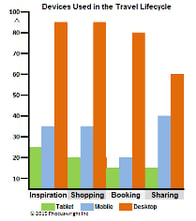
- Desktop is so dominant in Inspiration, Shopping and Booking the technology must support traveler work and objectives with significantly greater effectiveness.
- Travelers are highly flexible with technology. Desktop apparently loses its edge in effectiveness because Mobile and Tablet combine to reach parity in usage with it – an outcome which wasn’t even a possibility in the earlier lifecycle phases.
It’s reasonable to assume the role of mobile applications is consistent with this profile of device usage.
Apps likely play a very minor role in the Shopping phase because the overall use of apps for any kind of ecommerce has been documented as almost nonexistent. Tablets and Mobile devices are likely used for searches and mobile websites in the Shopping phase – not apps.
Travel Apps and Future Behavior
Revisiting the earlier three conclusions, the first (“growth is driven by real advantages to mobile users”) and third (“mobile technology is young so growth should only increase”) may guide our thoughts in a useful way.
Certainly they provide insight into four of the numbers in this table. Two of the numbers measure the percentage of leisure and business travelers who use mobile devices at any point in a travel experience; the other two measure the percentage of leisure/business travelers for whom mobile devices played any part in a travel experience. Both numbers are high – certainly high enough to dismiss the 1% use of travel apps as a false reading.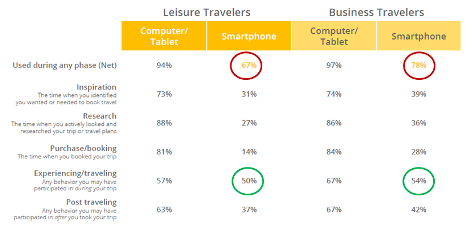
Mobile devices are part of almost everyone’s travel kit and people clearly use them whenever they bring value or benefits to a moment in time. Perhaps the better question would have been, “How will mobile apps change travel habits?” because the omnipresence of mobile devices creates an irresistible environment for raised expectations.
The TravList app provides an intriguing glimpse into how expectations may be raised in the near future. A key take-away from this app, no doubt likely for other travel apps as well, is how functionality is directly tied to providing immediate value to the travel experience: from being a paperless source of boarding passes, vouchers, rental contracts, etc. to a repository of essential trip details; from flight alerts to customized information for trip locations. Over time this availability of highly personalized information will cause people to view their mobile device and travel app as being closer to a personal concierge than software.

















